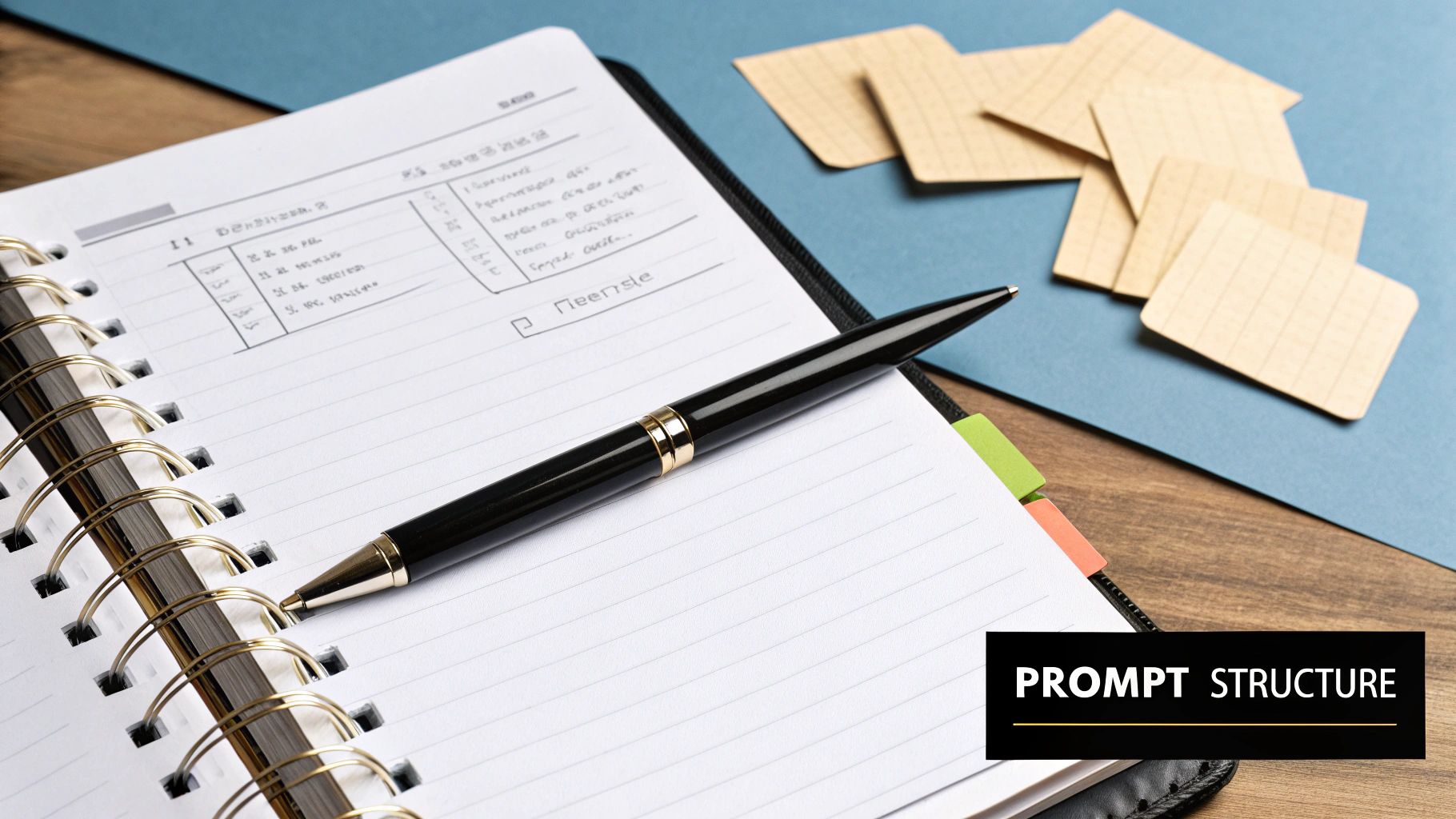how to write ai prompts
prompt engineering
ai prompts
chatgpt tips
ai writing
How To Write AI Prompts That Actually Work Every Time
Understanding What Makes AI Prompts Actually Work

Let's explore the core principles of effective AI prompting. We'll move beyond common misconceptions to understand what truly makes AI interactions successful. Many people struggle with inconsistent AI responses, unsure why their prompts sometimes work brilliantly and other times fail. This inconsistency often comes from a misunderstanding of how AI interprets instructions. This section aims to clarify that process.
Thinking Like an AI: Decoding the Interpretation Process
AI doesn't think like a human. It doesn't have common sense or understand implied meaning. Instead, it relies on patterns and probabilities learned from the massive datasets it's trained on. So, writing effective AI prompts is less about giving direct commands and more about guiding the AI toward the desired output with the right information and context.
For example, a vague prompt like "write a poem" will produce a generic result. But a prompt like "write a sonnet about the feeling of nostalgia for childhood summers" provides much clearer direction. This allows the AI to leverage its training data more effectively.
The Power of Clarity and Specificity
Ambiguity is a major obstacle to a good AI prompt. The more specific your prompt, the better the AI can understand your goals. This means clearly defining the desired output's format, length, style, and tone.
Providing relevant context and examples can also significantly improve the quality of results. Think of it like giving instructions to a human writer: the more detail you provide, the closer the result will be to your vision. You might be interested in: How to master OpenAI.
Common Pitfalls and How to Avoid Them
One common mistake is assuming the AI understands implied information. For example, asking for "marketing copy for a new phone" without specifying the phone's features or target audience gives the AI too much room for interpretation.
Another pitfall is overcomplicating the prompt. While specificity is important, excessive, unnecessary detail can confuse the AI. Focus on the essential information needed to guide the AI. Effective AI prompts are crucial for content creation and data analysis. In the U.S., 61% of content creators regularly use AI tools for writing, highlighting its growing importance for productivity and quality. Find more detailed statistics here.
Key Takeaways for Writing Effective Prompts
To write effective AI prompts, consider these key elements:
- Clarity: Use precise language and avoid ambiguity.
- Specificity: Provide details about format, style, length, and tone.
- Context: Give the AI the necessary background information.
- Examples: Show the AI what you're looking for.
- Iteration: Experiment and refine your prompts based on the AI’s responses.
By understanding how AI interprets instructions and avoiding common pitfalls, you can create effective prompts consistently. These techniques unlock AI's potential, transforming your interaction from frustrating guesswork into a powerful collaborative process.
The Essential Building Blocks Every Prompt Needs
Every high-performing AI prompt has a solid structure. We'll break down the crucial components prompt engineers use, from establishing clear context to giving the AI specific roles. This changes how the AI responds and delivers more customized results. Examining effective prompts reveals the balance between creativity and precision, understanding when examples are more effective than abstract instructions, and learning how to implement constraints. This guides the AI to create precisely what you want. This section will show you how to construct prompts that consistently yield high-quality results.

The infographic above shows the core process of creating effective AI prompts. This starts with pinpointing your goal and ends with establishing constraints. This process ensures the AI understands your objective, the necessary background information, and any limitations. Combining these elements reduces ambiguity and leads to predictable, high-quality outcomes.
Identify Your Goal: The Foundation of Every Prompt
Before writing anything, define the purpose of your prompt. What should the AI accomplish? Are you looking for a creative story, a concise summary of a complex topic, or code for a specific function? A clearly defined objective will guide your entire prompt-writing process.
For instance, if your goal is to generate marketing copy, specifying the target audience and tone is essential. This clarity helps the AI focus and generate relevant results. A well-defined goal is the first, vital step toward successful AI interaction.
Specify Context: Giving the AI the Background Information
Context is the background information that informs the AI’s understanding of your request. It sets the stage for the AI’s response. The more context you provide, the more informed and nuanced the AI's output.
This could involve the desired length, format, style, and tone. Including relevant keywords or examples can further refine the AI’s understanding. Providing context helps the AI produce responses tailored to your specific needs. It connects your goal to your desired output.
Determine Constraints: Guiding the AI Towards Your Vision
Constraints are the boundaries within which the AI operates. They refine the output by setting limits and specific requirements. This might include specifying a word count, restricting the use of certain terms, or requiring a particular format.
Constraints are especially valuable for precision tasks like translation or coding. They ensure the AI follows your guidelines. This control transforms the AI from a general tool into a specialized assistant, producing precisely what you need and saving revision time. Constraints shape the AI’s output into your desired form.
To further illustrate these components, let's look at a comparison table. The table below breaks down the essential components of a prompt and offers best practices for each.
Essential Prompt Components Comparison
| Component | Purpose | Impact on Results | Best Practices |
|---|---|---|---|
| Goal | Defines the objective of the prompt | Determines the overall direction and relevance of the AI’s response | Clearly state what you want the AI to achieve (e.g., write a poem, summarize an article, generate code). |
| Context | Provides background information and sets the scene for the AI | Influences the AI’s understanding and helps produce more nuanced and relevant outputs | Include details about the desired length, format, style, tone, audience, and any relevant keywords or examples. |
| Constraints | Sets limitations and specific requirements for the AI | Refines the AI’s output and ensures it adheres to specific guidelines | Specify word count limits, format restrictions, or prohibited terms. Be as specific as possible to guide the AI effectively. |
By understanding these core components and how they interact, you can craft effective prompts that deliver high-quality, tailored results. Each element plays a crucial role in guiding the AI toward producing exactly what you envision.
Mastering Different Prompt Types For Every Situation

Crafting effective prompts for AI is a nuanced skill. Different goals require different approaches. This section explores specific techniques for various situations, from igniting creative writing to tackling analytical tasks, problem-solving, and engaging in conversations.
Instructional Vs. Exploratory Prompts
A key distinction in prompt engineering lies in the difference between instructional prompts and exploratory prompts. Instructional prompts provide clear directions, similar to a recipe. They're ideal for specific outcomes, like generating product descriptions or translating text.
For instance, an instructional prompt could be: "Write a short story for children about a lost dog finding its way home."
On the other hand, exploratory prompts encourage the AI to brainstorm, generate diverse ideas, or delve deeper into a subject. You might use these when you want the AI to explore possibilities. An example would be: "What are some potential solutions to traffic congestion in urban areas?"
The market for AI essay writers is experiencing rapid growth. By 2025, these tools are projected to be integral to content creation. AI writing tool adoption is on the rise, with some regions seeing a 35% increase, such as in Italy. Effective prompt engineering is essential for maximizing the potential of AI. Learn more about this trend here.
Tailoring Prompts To Specific AI Tools
Just as you adjust your communication style depending on who you’re talking to, you should tailor your prompts to the specific AI tool you're using. Different tools have unique strengths and weaknesses. Some excel at creative writing, while others shine in analytical tasks.
The complexity of your prompt might also depend on the AI model's sophistication. Advanced models may require less explicit instruction, while simpler models need more detailed guidance. For a deeper dive into prompt generation, see our guide How to master prompt generation.
The Nuances Of Prompt Engineering
Even small changes in wording can significantly impact the AI’s output. Using strong verbs or specifying the desired tone can dramatically improve the results. Just like in any creative project, crafting impactful AI prompts often starts with a well-defined brief. This article on how to write a creative brief offers helpful insights.
Prompt Types By Task
Here are examples of prompt types suited for various tasks:
- Creative Writing: "Write a haiku about the first snowfall of winter."
- Analytical Tasks: "Analyze the key themes in Shakespeare's Hamlet."
- Problem Solving: "Develop a marketing strategy for a new mobile app."
- Conversational Interactions: "Let's discuss the impact of social media on society."
By understanding these different prompt types and adjusting your approach based on the situation and the AI tool, you can significantly improve the quality of your AI interactions and achieve your desired outcomes. Mastering prompt engineering involves understanding the technical aspects of AI models and having the creative ability to guide the AI toward your vision.
Advanced Techniques That Separate Pros From Beginners
Getting the basics of AI prompting down is a solid first step. But if you really want to tap into the power of AI models like GPT-4, you'll need to explore more advanced techniques. These are the tools expert prompt engineers use to get truly impressive results.
Chain-of-Thought Prompting: Guiding the AI's Reasoning
One key technique is chain-of-thought prompting. Think of it as guiding the AI through a problem, step by step, much like you would yourself. Instead of just asking for the answer, you're prompting the AI to explain its reasoning.
For example, instead of "What is 15 multiplied by 6?", a chain-of-thought prompt would be, "Explain how you would calculate 15 multiplied by 6, then give the answer." This encourages more accurate and reliable results, particularly for complex questions.
Few-Shot Learning: Teaching by Example
Few-shot learning is another powerful tool. This involves giving the AI a few examples of the input and output you want before the actual prompt. It helps the AI grasp the pattern and deliver better results. This is especially helpful for things like translation or generating code.
Prompt Chaining: Building Upon Previous Responses
Taking this further, prompt chaining uses the output of one prompt as the input for the next, creating a linked sequence. This lets you build upon previous responses, leading to more sophisticated and nuanced results. It opens up the possibility for complex, multi-step interactions with the AI.
Iterative Refinement: Perfecting Your Prompts
Rarely is a prompt perfect on the first try. Iterative refinement is the practice of constantly tweaking and testing prompts based on the AI’s responses. This feedback loop leads to progressively better results over time. For tailoring AI prompts to specific professional tasks, resources like How To Write Effective Ai Prompts For Sales Tasks can be invaluable.
Role-Playing and System Message Optimization
Assigning a specific role to the AI can dramatically change its output. Instructing the AI to "act like a marketing expert" will give you a different response than simply asking for marketing copy. Likewise, optimizing the system message gives the AI initial guidelines that shape its overall behavior.
Prompt Debugging and Edge Case Handling
Even with advanced strategies, you might run into errors or unexpected outputs. Prompt debugging helps identify and fix issues within your prompts. Learning to handle edge cases – unusual or unexpected input – is vital for robust prompt engineering. Resources like How to master OpenAI API provide more in-depth information on working with the OpenAI API.
To understand how these advanced techniques can improve results, let's take a look at the following data:
The table below summarizes the effectiveness of different advanced prompting techniques across various use cases.
Advanced Prompting Techniques Effectiveness
| Technique | Use Case | Effectiveness Rate | Complexity Level |
|---|---|---|---|
| Chain-of-Thought Prompting | Mathematical Reasoning | 85% | Medium |
| Few-Shot Learning | Code Generation | 70% | Low |
| Prompt Chaining | Story Writing | 90% | High |
| Iterative Refinement | Content Creation | 75% | Medium |
| Role-Playing | Customer Service | 65% | Low |
| System Message Optimization | Chatbots | 80% | Medium |
As you can see, techniques like Chain-of-Thought prompting and Prompt Chaining demonstrate high effectiveness rates, although they also come with higher complexity. Simpler techniques like Few-Shot Learning and Role-Playing can be quite effective for specific use cases and are easier to implement.
Pushing the Limits of AI While Maintaining Reliability
These advanced techniques help you explore the full potential of AI while keeping things reliable. Mastering them takes your AI interactions from simple Q&A to powerful collaborative partnerships, unlocking real creative and analytical power.
Avoiding The Mistakes That Kill Your Results

Even with a solid grasp of AI prompting, common mistakes can still undermine your results. This section explores frequent errors, offering clear strategies for avoiding them and empowering you to maximize your AI interactions.
The Pitfalls of Vague Instructions
Vague instructions often lead to disappointing AI outputs. Imagine asking a chef to "make something tasty" without specifics. The result might be edible, but unlikely to satisfy your preferences. AI, similarly, requires clear direction.
Asking "write about marketing" is too broad. Instead, try "Write a blog post about the benefits of content marketing for small businesses." This specificity guides the AI toward a more focused, useful outcome, a key principle in successful prompt engineering.
Overcomplicating Prompts: Less Is More
While context is important, excessive detail can overwhelm the AI. Think of it like giving someone overly complicated driving directions – they might get lost. Keep prompts concise, focusing on essential information.
Instead of cramming every keyword into your prompt, focus on core concepts. Avoid long, convoluted sentences. Well-structured, clear prompts are more effective than rambling ones, aiding efficient AI processing.
Context Limitations: Recognizing AI Boundaries
AI models have limitations in understanding context. They operate based on their training data, which may not encompass every nuance. Recognizing these limits is crucial for crafting effective prompts.
When addressing specialized topics, provide sufficient background. For example, when working with a specific software program like Figma, ensure the AI understands its functionality. This prevents misinterpretations and inaccurate outputs.
The Goldilocks Principle: Balancing Breadth and Narrowness
Effective prompts strike a balance between being too broad and too narrow. A broad prompt yields generic results, while a narrow one restricts the AI's creativity and utility.
Finding the "Goldilocks zone" – the right level of detail – is key. Testing and iterating on your prompts help achieve this balance.
The Power of Testing and Iteration
Testing and refining prompts is crucial. The first prompt rarely yields perfect results. Think of it like sculpting, refining a general shape through successive iterations.
Analyze the AI's output and adjust prompts accordingly. This iterative process might involve rephrasing, adding/removing details, and adjusting tone. This separates successful prompt engineers from beginners.
Troubleshooting AI Responses
Even with a well-crafted prompt, the AI can miss the mark. Troubleshooting skills are essential. Analyze the response and diagnose the issue.
Is the problem a lack of clarity, insufficient context, or a fundamental misunderstanding? Identifying the cause allows you to modify your prompt and retry. This constant learning strengthens your prompting abilities.
Where Prompt Engineering Is Headed Next
The world of AI is constantly changing, and how we communicate with it is changing too. Prompt engineering, once a specialized skill, is quickly becoming a must-have for anyone using AI tools. This shift opens up exciting new possibilities for how we interact with AI.
The Rise of Specialized Prompting Tools
AI models are becoming more advanced, and so are the tools we use to work with them. We're seeing growth in specialized prompting tools built for specific jobs like copywriting, generating code, or analyzing data. These tools often use advanced techniques like few-shot learning and chain-of-thought prompting, making it easier for users to get great results.
This trend shows that a one-size-fits-all approach to prompting isn't effective in a world with so many different AI applications. Many of these tools also provide pre-made templates and easy-to-use interfaces, making complex prompting techniques accessible to more people.
The Growing Demand for Prompt Engineering Expertise
Businesses across various industries are using AI more and more, and this has led to a surge in demand for prompt engineers. Writing effective prompts for AI has changed significantly in recent years, especially with the rise of AI writing tools. By 2025, the need for professionals skilled in creating effective AI prompts is projected to rise. This is connected to a broader trend where 97 million new AI-related jobs are expected by 2025, including roles like AI editors and prompt engineers. The widespread use of AI tools in major markets is pushing the need for precise and strategic prompt crafting. More detailed statistics can be found here.
This increasing demand shows how valuable well-written prompts are for getting the most out of AI. Knowing how to write good AI prompts is no longer just a helpful skill; it's a potential career path. Companies realize they need experts who can optimize how people interact with AI to get the best results.
The Future of Human-AI Collaboration
The future of prompt engineering suggests a closer, more collaborative relationship between humans and AI. We can expect more user-friendly interfaces and tools that simplify refining and experimenting with prompts. This will blur the line between giving instructions and having a conversation with the AI.
Imagine AI that can anticipate your needs based on past interactions, proactively offering prompt suggestions and improvements to help you reach your goals. This represents a move away from simply telling the AI what to do, towards a more nuanced partnership where humans and AI work together on complex challenges.
Essential Skills for the Future Prompt Engineer
The skills needed for prompt engineering are going beyond just knowing how to structure a prompt. Future prompt engineers will need a combination of technical knowledge and creative thinking. This includes understanding how AI models work, the ability to analyze AI output and identify problems, and the creativity to design prompts that get the responses you want.
Being adaptable and willing to learn new techniques will be essential because this field changes so quickly. Platforms with diverse AI applications, like AnotherWrapper, offer a great way to develop these skills and explore the possibilities of AI-powered projects.
Key Takeaways
Your journey to mastering AI prompt engineering begins now. This section distills everything discussed into actionable steps you can implement immediately, providing a practical roadmap for success.
From Beginner to Advanced: A Clear Progression Path
Whether you're new to AI prompts or seeking to refine existing skills, a clear progression path is crucial. Start by understanding the fundamental components of a prompt: goal, context, and constraints.
Next, explore different prompt types. Experiment with instructional prompts for direct commands and exploratory prompts for brainstorming and idea generation. Gradually incorporate advanced techniques like chain-of-thought prompting, few-shot learning, and prompt chaining to improve the AI's reasoning and output quality.
Practice Makes Perfect: Exercises for Every Skill Level
Consistent practice is key to mastering any skill, and prompt engineering is no different. Start with simple exercises, like writing prompts for various content formats:
- Poems: "Write a haiku about a blooming sunflower."
- Summaries: "Summarize the plot of Romeo and Juliet in 50 words."
- Code: "Write Python code to calculate the factorial of a number."
As you gain confidence, move on to more complex exercises. Try crafting prompts for specific tasks such as:
- Generating marketing copy for a new product.
- Creating different versions of a story with varying emotional tones.
- Developing outlines for complex topics.
Ready-to-Use Templates: Jumpstart Your Prompting
Harness the efficiency of templates to streamline your prompt writing. Templates provide a strong foundation, allowing you to quickly adapt and customize them for different situations. Create a library of templates for common tasks like:
- Blog post outlines: "Outline a blog post about [topic] for [audience]."
- Product descriptions: "Write a product description for [product] highlighting its key features and benefits."
- Social media posts: "Generate a tweet about [topic] with relevant hashtags."
Building Your Personal Prompt Library: Organize and Optimize
As you experiment and refine your prompts, organize them into a personal library. This becomes an invaluable resource, allowing you to quickly retrieve and reuse effective prompts, saving you time and effort. Categorize prompts by task, content type, or AI model. Regularly review and update your library to include new techniques and optimize existing prompts based on their performance.
Tracking Improvement and Continuous Refinement
Track your progress to measure improvements and pinpoint areas for growth. Observe which prompts consistently produce desired results and which need further refinement. Analyze the AI’s output, noting both successes and failures. Use this feedback to iteratively improve prompts, adjusting the wording, context, and constraints as needed.
Recommended Tools, Communities, and Resources
Engage with a supportive network and use helpful resources. Explore online communities focused on prompt engineering, share your experiences, and learn from others. Consider tools like AnotherWrapper, which provides integrated AI capabilities and simplifies the development of AI-powered applications. This lets you focus on prompt engineering and product innovation rather than complex configurations.
Realistic Benchmarks: Measuring Progress and Celebrating Wins
Set realistic benchmarks to gauge your progress and acknowledge your accomplishments. Don't aim for perfection immediately. Concentrate on gradual improvement. Track metrics like the frequency of successful AI responses, the time spent creating effective prompts, and the overall quality of the AI-generated content. Celebrate milestones to stay motivated and maintain a positive learning experience. Start building amazing AI-powered projects today with AnotherWrapper. This comprehensive AI starter kit offers everything you need to launch your next big idea. Check it out at AnotherWrapper.
Fekri




